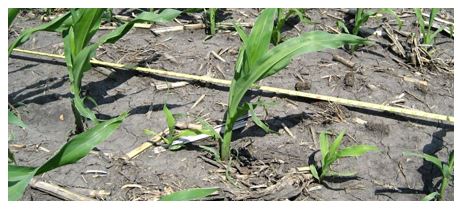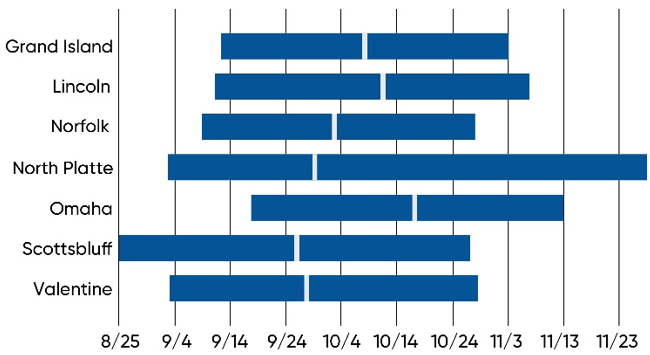Many different stress factors are capable of reducing corn stands, such as:
- Cold or wet soils.
- Insect feeding.
- Unfavorable weather conditions.

Stand Counts
- Take several sample counts to represent the field.
- Sample a length of row equal to 1/1000th of an acre.
- Measure off the distance appropriate for your row width, count the number of live plants and multiply by 1000 to obtain an estimate of plants/acre.


- In situations such as flooding damage, only a portion of the field may need to be considered for replant.
- Frost or hail can damage a wide area. In this case plant density and health should be assessed across the entire field.
- When an injury event such as frost or hail occurs it is best to wait a few days to perform a stand assessment, as it will allow a better determination of whether or not plants will recover.

Growth of green tissue near the growing point indicates that this plant would have recovered.

Soft translucent tissue near the growing point indicates that this plant will not recover.
After a plant stand has been assessed it is important to consider other factors such as:
- Is the stand consistent, are large gaps present?
- Will the stand have adequate crop canopy to assist with weed control and irrigation efficiencies?
- Will replanting provide an economic gain?
- Are the remaining plants healthy and relatively equal in maturity?
Replant Yield Potential
- The expected yield from the current stand should be compared to expected replant yield.
Table 1. Yield potential for a range of plant populations and planting dates (Nafziger, E. 2020. Replanting Corn and Soybeans. Univ. of Illinois).

Other Factors to Evaluate
- Stand uniformity - An uneven stand will yield less than a relatively even stand with the same number of plants.
- Plant health - Plants that are severely injured or defoliated will have reduced photosynthetic capability and a lower yield potential.
Corn yield is influenced by stand density as well as stand uniformity:
- Variation in plant size can have a negative impact on yield.
- Plants with delayed emergence or development are at a competitive disadvantage with larger plants in the stand and will have reduced leaf area, biomass, and yield.



Figure 1. Yield potential of delayed and uneven corn stands.
(Data from Carter, P.R., E.D. Nafziger, and J.G. Lauer, Uneven emergence in corn, North Central Regional Extension Publication No. 344)
Hybrid Maturity Selection for Delayed Planting
- A frequent question pertaining to replanting corn is how full season of a hybrid can be planted and still reach normal physiological maturity.

Figure 2. Earliest, latest, and average dates of first fall frost (<32 ºF) in several Nebraska locations over the past 50 years. (Source: High Plains Regional Climate Center)

Figure 3. Dates at which there is a 80% probability of an autumn freeze of 32°F or less. (Source: USDA-NASS)
- When considering which hybrid to replant, consider GDU accumulation between the planting date and average first frost date and hybrid GDU requirements to reach physiological maturity.
- Research has shown that corn can adjust its growth and development, requiring fewer growing degree units (GDU’s) to reach maturity when planted late. Late-planted corn showed a reduction in GDU requirements of about six GDU’s per day of planting delay.
Table 2. Average accumulated growing degree units (GDUs) between emergence dates and average first frost date for several locations in Nebraska. (Source: High Plains Regional Climate Center)

Author: Mark Jeschke
May 2020
The foregoing is provided for informational use only. Please contact your Pioneer sales professional for information and suggestions specific to your operation. Product performance is variable and depends on many factors such as moisture and heat stress, soil type, management practices and environmental stress as well as disease and pest pressures. Individual results may vary. Pioneer® brand products are provided subject to the terms and conditions of purchase which are part of the labeling and purchase documents.